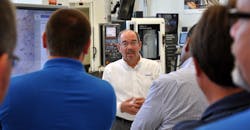All students comprehend and retain information differently, and nowhere is this more evident than when it comes to teaching engineers and other technically minded groups. The key helping them grasp new ideas or concepts, as is also the case with students in other fields of study, is always to speak to their specific interests. For engineers and techies, that means instructional messages must appeal to their logical sensibilities and their desire to physically engage with the subject matter.
A successful teaching strategy hinges on two primary goals: get students to retain and apply the information. With that said, instructors first must identify what motivates their students and then tailor the material accordingly, to ensure they achieve those primary goals.
For example, consider machinists in training programs. Most likely the prospect of abundant and lucrative employment opportunities will motivate that particular group of students. So, teachers and instructors should emphasize how the subject matter being taught will help the students become more valuable to potential employers.
Likewise, new cutting tool technology and how it will benefit production operations, for instance, may be what motivates a group of shop engineers in a cutting tool training class. Cutting tool distributors in that same class may want to retain and apply the information, being motivated to sell new products more effectively to their customers.
Once students understand the direct benefits of learning, teachers and instructors then must teach them in a manner that is closely aligned with the way the students learn. Engineers and other tech types are more likely to engage with the subject matter once two elements are in place:
1) the students grasp the logic behind the new information; and,
2) they realize the immediate cause and effect of implementation.
Among the many teaching strategies, the long-established and popular Socratic method is one that works to engage a student’s reasoning effectively. Essentially, the method teaches by posing a series of questions that reveal to students how new information logically builds on what they know already. As students take ownership of the lesson, they prove to themselves the usefulness of the new information.
The Socratic method relies on audience participation, so it keeps students involved, which further increases the likelihood that they will retain the information.
Another way teachers gain and hold student attention is through vivid visualizations. An instructor verbally paints a clear picture of cutting tool movement and its improved performance. As students focus on these mental images, they remain fully engaged. As a result of the concrete representations, they are more likely to remember the material.
In addition to the Socratic method and its logical building of information, the kinesthetic method is one that allows technical students to absorb information, in particular, through hands-on learning.
To apply this method to teaching about cutting tool innovations, for instance, instructors will have students implement the information they just learned by running the tools on live machines. The students experience immediate results and can then tweak the cutting parameters through trial and error in a risk-free setting. This process builds their confidence and increases the likelihood that they will continue to use their newly acquired skills and knowledge.
For example, after discussing the significant advantages of overlay tool coatings, students could then test that information. They might run 304 stainless steel at 1,000 SFM and observe the extremely low, 3-second tool life. They could then test a tool with a thin – 2.5 µm thick – physical vapor deposition coating and watch tool life increase to 45 seconds. While that short amount of time might not be commercially important, it is a huge improvement and leaves a strong impression.
With an even thicker – 15 µm thick – chemical vapor deposition coating, tool life increases dramatically to 15 minutes. This exercise convinces students of the value of coatings, and also teaches them the right circumstances to apply different types.
While kinesthetic learning is an excellent teaching method, it may be ineffective for certain class formats – such as online training courses – where access to machine tools is nonexistent. However, advanced simulation software and portable simulation systems can mimic machine behavior and provide students the same experience they would have if they were actually in front of a real machine.
Tailored teaching approaches, such as kinesthetic learning and the Socratic method, ensure that students, especially those in manufacturing, retain training subject matter and gain the confidence to then implement what they’ve learned. And as these students enter and progress in their chosen fields, they must continue to learn and apply new information as a critical component of not only their career growth, but that of the industry as a whole. Training exposes these professionals to new tools, resources and strategies they need to survive and prosper.
About the Author
Don Graham
Manager, Education Services.
Don Graham is Manager, Education Services for SECO Tools LLC. He is responsible for internal and external education programs, including the STEP - SECO Technical Education Program; Seco application support; and new product development. He also oversees the resources of the product team and field-based educators.
